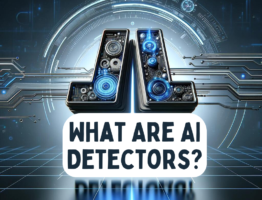AI detectors are becoming more popular than they ever were before, mostly due to the fact that AI has exploded, along with its use in implementation in everyday life.
But what do AI detectors do, or how do they work? And which ones are the best? Lets dive in.
Understanding AI Detectors
What are AI Detectors?
AI detectors, also known as AI writing detectors or AI content detectors, are tools developed to identify text, images, or videos generated by AI technologies, such as ChatGPT or image generation models.
Their primary function is to analyze content and determine if it has been produced by a human or an AI.
How Do AI Detectors Work?
The core mechanism of AI detectors revolves around analyzing specific attributes of content, notably perplexity and burstiness.
Perplexity measures the predictability of a text — AI tends to create content with low perplexity, meaning it’s more coherent and less likely to perplex the average reader.
Burstiness, on the other hand, evaluates variation in sentence structure and length. AI-generated texts often exhibit low burstiness due to their tendency to produce sentences of average length and conventional structure.
What is the best AI detector?
There are many AI detectors, like GPTzero, copyleaks, and Undetectable.ai. All AI detectors are a little bit different, and some cost money to use. But when it comes to using an AI detector, which one is actually the best? Between trying them all we found that one was truly the leader of them all.

Undetectable.ai shines as the best AI detector. Not only is is free, it also shows you how copyleaks, crossplag, and other detectors will likely see your text.
Imagine 10 AI detectors combined in one, that is essentially what Undetectable.ai is, and the best part is its free!
The Role of AI Detectors in Various Sectors
AI detectors find their relevance in various domains:
- Education: To ensure academic integrity by detecting AI-generated essays or assignments.
- Digital Marketing: To identify fake product reviews or AI-generated spam content.
- Journalism and Media: To verify the authenticity of articles and reports.
- Creative Arts: To differentiate between human-made and AI-generated artworks or literary pieces.
Reliability and Challenges
While AI detectors are a promising development, they are not infallible. Their reliability can be influenced by several factors:
- Complexity of AI-generated Content: Advanced AI models can generate content that closely mimics human writing, making detection more challenging.
- Editing and Paraphrasing: AI-generated content that has been significantly edited or paraphrased by a human can evade detection.
- Short Texts: Detecting AI involvement in shorter texts is often more difficult due to less data for analysis.
Metrics for Assessing AI Detectors
To evaluate the effectiveness of AI detectors, various metrics are used:
- Precision: The accuracy of the detector in identifying AI-generated content.
- Recall: The detector’s ability to correctly identify all AI-generated instances.
- F1 Score: A balance between precision and recall, providing a comprehensive accuracy assessment.
Future of AI Detectors
The future of AI detectors lies in their continuous development and adaptability. As AI technologies evolve, so must the detectors. This includes:
- Enhanced Machine Learning Models: To improve accuracy and reduce false positives and negatives.
- Integration of New Metrics: To better analyze and understand AI-generated content.
- Collaboration with AI Developers: For creating more refined detection methods, possibly including ‘watermarks’ in AI-generated content.
Ethical Considerations
The deployment of AI detectors also raises important ethical questions:
- Privacy Concerns: Ensuring that the use of AI detectors does not infringe on individual privacy rights.
- Bias and Fairness: Addressing potential biases in AI detectors that could lead to unfair targeting or discrimination.
- Transparency and Accountability: Maintaining a level of transparency about how detectors are used and ensuring accountability for their outcomes.
Conclusion
AI detectors represent a crucial step in maintaining the authenticity and integrity of digital content. As AI technologies continue to advance, the role of these detectors will become increasingly significant in distinguishing between human and AI-generated content. However, it is equally important to focus on the ethical implications and ensure that these tools are used responsibly and fairly.
The journey of AI detectors is not just about technological advancement; it’s also about navigating the intricate balance between innovation and authenticity, and between automation and human creativity. As we move forward, the development and refinement of AI detectors will play a pivotal role in shaping a future where digital authenticity is preserved without compromising on the benefits brought by AI.




